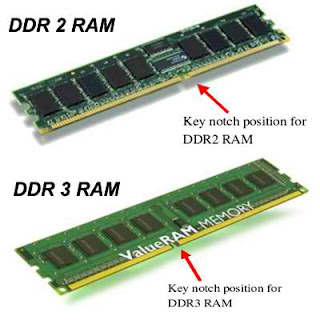Not-so-old vs. Not-so-new
DDR2 (Double Data Rate 2) memory has been available for quite some time. New computers, even computers released within the last three years or so come equipped with DDR2 memory. An improvement over DDR memory, DDR2 produces faster performance with less energy consumption. With the way that DDR memory products are designed, none is backwards or forward compatible with the other. For example, if you have DDR memory, you will not be able to upgrade using DDR2 or DDR3 memory. You can only upgrade DDR memory with other DDR memory.
As for DDR3, it is essentially doing what DDR2 has done with DDR. DDR3 performs faster, and consumes less power as it works. The past year has seen a steady decline in price with DDR3, and it currently is about on par in price range with DDR2. More specific information in regards to performance and price will be discussed below.
As for DDR3, it is essentially doing what DDR2 has done with DDR. DDR3 performs faster, and consumes less power as it works. The past year has seen a steady decline in price with DDR3, and it currently is about on par in price range with DDR2. More specific information in regards to performance and price will be discussed below.
Performance Differences
DDR3 uses significantly less power, and can run much faster. It uses 1.5V per chip, which is 0.3V less than DDR2. Additionally, when it comes to its Data rate, DDR2 (depending on its chip) can run at 400-1066 MT/s (megatransfer per second). In regards to its peak transfer rate, it can transfer from 3200-8533 MB/s. DDR3, on the other hand, can run from 800-2133 MT/s and 6400-17066 MB/s. In regards to the I/O bus clock, DDR2 is only available between 200-800 MHz, whereas DDR3 supports from 400-1600 MHz. Essentially, DDR3, when there are improvements from DDR2, can double in processing power. The fact that DDR3 consumes less power in outperforming DDR2 is impressive.
DDR3 uses significantly less power, and can run much faster. It uses 1.5V per chip, which is 0.3V less than DDR2. Additionally, when it comes to its Data rate, DDR2 (depending on its chip) can run at 400-1066 MT/s (megatransfer per second). In regards to its peak transfer rate, it can transfer from 3200-8533 MB/s. DDR3, on the other hand, can run from 800-2133 MT/s and 6400-17066 MB/s. In regards to the I/O bus clock, DDR2 is only available between 200-800 MHz, whereas DDR3 supports from 400-1600 MHz. Essentially, DDR3, when there are improvements from DDR2, can double in processing power. The fact that DDR3 consumes less power in outperforming DDR2 is impressive.

No comments:
Post a Comment